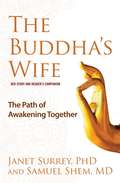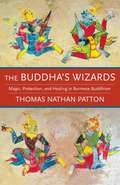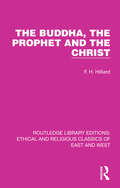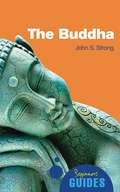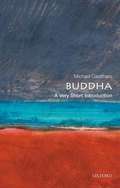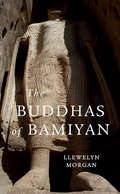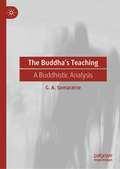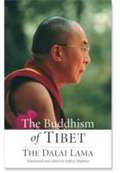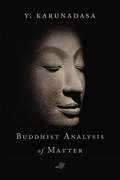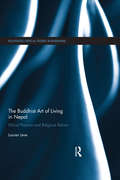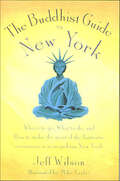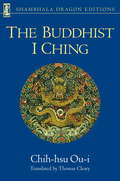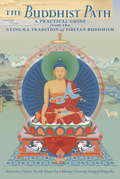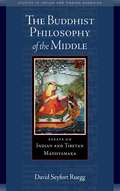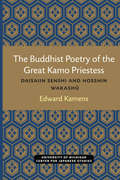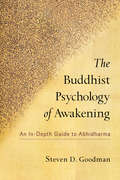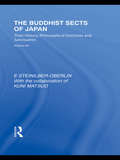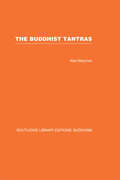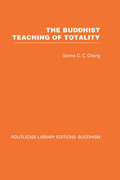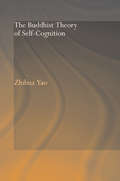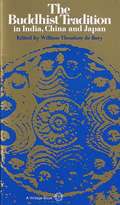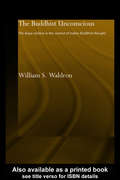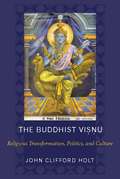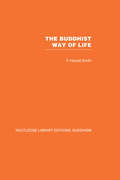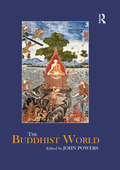- Table View
- List View
The Buddha's Wife
by Samuel Shem Janet SurreyAs the category of women's spirituality continues to grow, The Buddha's Wife offers to a broad audience for the first time the intimate and profound story of Princess Yasodhara, the wife Buddha left behind, and her alternative journey to spiritual enlightenment.What do we know of the wife and child the Buddha abandoned when he went off to seek his enlightenment? The Buddha's Wife brings this rarely told story to the forefront, offering a nuanced portrait of this compelling and compassionate figure while also examining the practical applications her teachings have on our modern lives. Princess Yasodhara's journey is one full of loss, grief, and suffering. But through it, she discovered her own enlightenment within the deep bonds of community and "ordinary" relationships. While traditional Buddhism emphasizes solitary meditation, Yasodhara's experience speaks of "The Path of Right Relation," of achieving awareness not alone but together with others. The Buddha's Wife is comprised of two parts: the first part is a historical narrative of Yasodhara's fascinating story, and the second part is a "how-to" reader's companion filled with life lessons, practices, and reflections for the modern seeker. Her story provides a relational path, one which speaks directly to our everyday lives and offers a doorway to profound spiritual maturation, awakening, and wisdom beyond the solitary, heroic journey.
The Buddha's Wizards: Magic, Protection, and Healing in Burmese Buddhism
by Thomas Nathan PattonWizards with magical powers to heal the sick, possess the bodies of their followers, and defend their tradition against outside threats are far from the typical picture of Buddhism. Yet belief in wizard-saints who protect their devotees and intervene in the world is widespread among Burmese Buddhists. The Buddha’s Wizards is a historically informed ethnographic study that explores the supernatural landscape of Buddhism in Myanmar to explain the persistence of wizardry as a form of lived religion in the modern era.Thomas Nathan Patton explains the world of wizards, spells, and supernatural powers in terms of both the broader social, political, and religious context and the intimate roles that wizards play in people’s everyday lives. He draws on affect theory, material and visual culture, long-term participant observation, and the testimonies of the devout to show how devotees perceive the protective power of wizard-saints. Patton considers beliefs and practices associated with wizards to be forms of defending Buddhist traditions from colonial and state power and culturally sanctioned responses to restrictive gender roles. The book also offers a new lens on the political struggles and social transformations that have taken place in Myanmar in recent years. Featuring close attention to the voices of individual wizard devotees and the wizards themselves, The Buddha’s Wizards provides a striking new look at a little-known aspect of Buddhist belief that helps expand our ways of thinking about the daily experience of lived religious practices.
The Buddha, The Prophet and the Christ (Ethical and Religious Classics of East and West #1)
by F. H. HilliardOriginally published in 1956, this book brings together from the canonical writings of Buddhism, Islam and Christianity the most important of the passages in which the view of the Founder is reflected. It aims to let each of the sacred traditions tell its own story and only such comments have been added as seem necessary to bring out the full significance of the passage quoted. The final chapter summarizes some of the difficult questions which arise from a comparison of the extracts from the 3 traditions.
The Buddha: A Beginner's Guide (Beginner's Guides)
by John S. StrongFrom his many births to his deathbed deeds, this authoritative biography unites the Buddha of history with the Buddha of legend in a bid to reveal the lasting spiritual relevance at the heart of the Buddhist tradition. Acclaimed scholar John Strong examines not only the historical texts, but also the supernatural accounts that surround this great religious figure, uncovering the roots of many Buddhist beliefs and practices. John Strong is Professor and Chair of the Department of Philosophy and Religion at Bates College in Maine, USA.
The Buddha: A Very Short Introduction
by Michael CarrithersMichael Carrithers guides us through the complex and sometimes conflicting information that Buddhist texts give us about the life and teaching of the Buddha. He discusses the social and political background of India in the Buddha's time and traces the development of his thought. He also assesses the rapid and widespread assimilation of Buddhism and its contemporary relevance. Well-paced and informative, this introduction will enlighten not only those who study Buddhism and comparative religion but anyone intrigued by the remarkable philosophy of one of the greatest religious thinkers.
The Buddhas of Bamiyan
by Llewelyn MorganFor 1,400 years, two colossal figures of the Buddha overlooked the fertile Bamiyan Valley on the Silk Road in Afghanistan. Witness to a melting pot of passing monks, merchants, and armies, the Buddhas embodied the intersection of East and West, and their destruction by the Taliban in 2001 provoked international outrage. Llewelyn Morgan excavates the layers of meaning these vanished wonders hold for a fractured Afghanistan. Carved in the sixth and seventh centuries, the Buddhas represented a confluence of religious and artistic traditions from India, China, Central Asia, and Iran, and even an echo of Greek influence brought by Alexander the Great’s armies. By the time Genghis Khan destroyed the town of Bamiyan six centuries later, Islam had replaced Buddhism as the local religion, and the Buddhas were celebrated as wonders of the Islamic world. Not until the nineteenth century did these figures come to the attention of Westerners. That is also the historical moment when the ground was laid for many of Afghanistan’s current problems, including the rise of the Taliban and the oppression of the Hazara people of Bamiyan. In a strange twist, the Hazaras-descendants of the conquering Mongol hordes who stormed Bamiyan in the thirteenth century-had come to venerate the Buddhas that once dominated their valley as symbols of their very different religious identity. Incorporating the voices of the holy men, adventurers, and hostages throughout history who set eyes on the Bamiyan Buddhas, Morgan tells the history of this region of paradox and heartache.
The Buddha’s Teaching: A Buddhistic Analysis
by G. A. SomaratneThis book approaches the Dhamma, the Buddha’s teaching, from a Buddhistic perspective, viewing various individual teachings presented in hundreds of early discourses of Pali canon, comprehending them under a single systemic thought of a single individual called the Buddha. It explicates the structure of this thought, going through various contextual teachings and teaching categories of the discourses, treating them as necessary parts of a liberating thought that constitutes the right view of one who embraces the Buddha’s teaching as his or her sole philosophy of life. It interprets the diverse individual dhammas as being in congruence with each other; and as contributory to forming the whole of the Buddha’s teaching, the Dhamma. By exploring some selected topics such as ignorance, configurations, not-self, and nibbāna in thirteen chapters, the book enables readers to understand the whole (the Dhamma) in relation to the parts (the dhammas), and the parts in relation to the whole, while realizing the importance of studying every single dhamma category or topic not for its own sake but for understand the entirety of the teaching. This way of viewing and explaining the teachings of the discourses enables readers to clearly comprehend the teaching of the Buddha in early Buddhism.
The Buddhism of Tibet
by Dalai Lama Jeffrey HopkinsUnlike most books by the Dalai Lama, this book consists of two texts that he himself wrote and two that he chose--all aimed at helping Western readers become better grounded in Buddhism.
The Buddhist Analysis of Matter
by Y. KarunadasaA fluent English explanation of the Theravada Buddhist analysis of matter for serious students of Buddhist thought.In The Buddhist Analysis of Matter, renowned scholar Y. Karunadasa interprets the Buddhist view of matter as presented in Theravada Buddhism, based on the Abhidhamma. His comprehensive work draws on both the earlier period containing the seven manuals of the Abhidhamma Pitaka and the later period containing Abhidhammic commentaries, sub-commentaries, and such compendiums as the Abhidhammatthasangaha of Acariya Anuruddha. In order to bring the subject into a wider perspective, and for more precision, Karunadasa considers the (non-Theravada) Vaibhasika and Sautrantika schools of Buddhism—two of the leading non-Mahayana schools with whom the Theravadins had much in common, both of which subscribed to a realistic view of existence—as well as later sources such as the post-canonical commentaries and related literary sources of Theravada Buddhism. This book gives us the first clear picture of the Buddhist analysis of matter as such. Earlier works on this subject have tended to focus on the broad philosophical implications arising from the Buddhist theory of matter and were based more on earlier sources, such as the Pali canonical texts. The Buddhist Analysis of Matter provides a much-needed micro view of the topic with a detailed examination of the Theravadins&’ list of rupa-dammas—the ultimate irreducible factors into which material existence is analyzed. It exposes the basic material elements into which the whole of material existence is resolved and explains their interconnection and interdependence on the basis of conditional relations. It concludes with an understanding of the nature and relevance of the Buddhist analysis of matter in the context of Buddhism as a religion.
The Buddhist Art of Living in Nepal: Ethical Practice and Religious Reform (Routledge Critical Studies in Buddhism)
by Lauren LeveTheravada Buddhism has experienced a powerful and far-reaching revival in modern Nepal, especially among the Newar Buddhist laity, many of whom are reorganizing their lives according to its precepts, practices and ideals. This book documents these far-reaching social and personal transformations and links them to political, economic and cultural shifts associated with late modernity, and especially neoliberal globalization. Nepal has changed radically over the last century, particularly since the introduction of liberal democracy and an open-market economy in 1990. The rise of lay vipassana meditation has also dramatically impacted the Buddhist landscape. Drawing on recently revived understandings of ethics as embodied practices of self-formation, the author argues that the Theravada turn is best understood as an ethical movement that offers practitioners ways of engaging, and models for living in, a rapidly changing world. The book takes readers into the Buddhist reform from the perspectives of its diverse practitioners, detailing devotees' ritual and meditative practices, their often conflicted relations to Vajrayana Buddhism and Newar civil society, their struggles over identity in a formerly Hindu nation-state, and the political, cultural, institutional and moral reorientations that becoming a "pure Buddhist"—as Theravada devotees understand themselves—entails. Based on more than 20 years of anthropological fieldwork, this book is an important contribution to scholarly debates over modern Buddhism, ethical practices, and the anthropology of religion. It is of interest to students and scholars of Asian Religion, Anthropology, Buddhism and Philosophy.
The Buddhist Guide to New York
by Jeff WilsonBuddhism in New York is as exciting and diverse as the city itself, but can be just as overwhelming for those new to the practice. What's a good temple or practice center to try for your first visit? What should you wear? What are the differences between the various schools? With The Buddhist Guide to New York, you can find a supportive community in which to explore the wisdom offered by this 2,500-year-old tradition. The book includes:* A brief introduction to Buddhism and the different schools, from Pure Land to Zen* General etiquette for visiting temples* Practice centers in all five boroughs, New York State, New Jersey, and Connecticut* Tibetan stores and restaurants* Buddhist health practitioners* Museums and cultural resources* Bookstores, publications, educational institutions, and other resourcesWhether you're a new explorer of Buddhism or a long-time practitioner, The Buddhist Guide to New York by Jeff Wilson will help you enjoy everything the region has to offer.
The Buddhist I Ching
by Thomas Cleary Chih-Hsu Ou-IFor centuries the I Ching has been used as a basic map of conscious development, containing the underlying principles of all religions, and highly prized by followers of Buddhism. Chih-hsu Ou-i uses the concepts of Tianti Buddhism to elucidate the I Ching--concentration and insight, calmness and wisdom, and various levels of realization. Skillfully translated by Thomas Cleary, this work presents the complete text of the I Ching plus the only Buddhist interpretation of the oracle.
The Buddhist Path
by Khenchen Palden Sherab Rinpoche Khenpo Tsewang Dongyal Rinpoche"An accessible and practical introduction to Tibetan Buddhism as practiced in the Nyingma or 'ancient' tradition, The Buddhist Path presents for us the proper way of cultivating intellect and heart so that our true nature can manifest. The authors provide clear explanations and methods that reveal how the mind functions and what its essence, our primordial nature, is. They impart detailed instructions on how to meditate, using methods ranging from generating calm abiding to the tantric techniques of visualization, mantra, and formless meditation. "
The Buddhist Philosophy of the Middle
by Tom J. Tillemans David Seyfort RueggMadhyamaka, the "philosophy of the middle," systematized the Buddha's fundamental teaching on no-self with its profound non-essentialist reading of reality. Founded in India by Nagarjuna in about the second century CE, Madhyamaka philosophy went on to become the dominant strain of Buddhist thought in Tibet and exerted a profound influence on all the cultures of East Asia. Within the extensive Western scholarship inspired by this school of thought, David Seyfort Ruegg's work is unparalleled in its incisiveness, diligence, and scope. The Buddhist Philosophy of the Middle brings together Ruegg's greatest essays on Madhyamaka, expert writings which have and will continue to contribute to our progressing understanding of this rich tradition.
The Buddhist Poetry of the Great Kamo Priestess: Daisaiin Senshi and Hosshin Wakashu (Michigan Monograph Series in Japanese Studies #5)
by Edward KamensSenshi was born in 964 and died in 1035, in the Heian period of Japanese history (794–1185). Most of the poems discussed here are what may loosely be called Buddhist poems, since they deal with Buddhist scriptures, practices, and ideas. For this reason, most of them have been treated as examples of a category or subgenre of waka called Shakkyoka, “Buddhist poems.” Yet many Shakkyoka are more like other poems in the waka canon than they are unlike them. In the case of Senshi’s “Buddhist poems,” their language links them to the traditions of secular verse. Moreover, the poems use the essentially secular public literary language of waka to address and express serious and relatively private religious concerns and aspirations. In reading Senshi’s poems, it is as important to think about their relationship to the traditions and conventions of waka and to other waka texts as it is to think about their relationship to Buddhist thoughts, practices, and texts. The Buddhist Poetry of the Great Kamo Priestess creates a context for the reading of Senshi’s poems by presenting what is known and what has been thought about her and them. As such, it is a vital source for any reader of Senshi and other literature of the Heian period.
The Buddhist Psychology of Awakening: An In-Depth Guide to Abhidharma
by Steven GoodmanA modern introduction to traditional Buddhist psychology This practical overview of Buddhist psychology outlines step-by-step methods for examining the source of our habitual tendencies and hangups. In order to truly free ourselves from perpetuating patterns of suffering, the Buddha offered a clear system for understanding our psychological dispositions, processes, fixations, and challenges--a system known as the Abhidharma. This tradition has been studied by Buddhists for over two millennia. Professor Steven Goodman has taught on the Abhidharma in both universities and Buddhist retreats for over twenty years, making these traditional teachings accessible for a modern readership for the first time. Goodman explains how becoming aware of our mental patterns can liberate us from cycles of emotional pain and shows how the Abhidharma can be applied to meditation practice through exercises of observation and reflection. This is the go-to manual for anyone interested in the world of Buddhist psychology.
The Buddhist Sects of Japan: Their History, Philosophical Doctrines and Sanctuaries (Routledge Library Editions: Japan)
by E Steinilber-OberlinThe philosophy of Buddhism, originating in India, has undergone considerable changes in its adoption in the Far East. It has, in Japan, assumed a more practical aspect, and has come to play an important role in the everyday life of action. But in this process Japanese Buddhism has split itself into many sects with greatly differing doctrines, though all profess a method destined to elevate the soul and a method of action. The understanding of this spiritual movement is an important key to the understanding of the contemporary Japanese state of mind, and The Buddhist Sects of Japan gives the first complete account of it in the English language.
The Buddhist Tantras: Light on Indo-Tibetan Esotericism (Routledge Library Editions: Buddhism)
by Alex WaymanOriginally published in 1973. The volume is divided into four sections: The introduction places the position of the Buddhist Tantras within Mahayana Buddhism and recalls their early literary history, especially the Guhyasamahatantra; the section also covers Buddhist Genesis and the Tantric tradition. The foundations of the Buddhist Tantras are discussed and the Tantric presentation of divinity; the preparation of disciples and the meaning of initiation; symbolism of the mandala-palace Tantric ritual and the twilight language. This section explores the Tantric teachings of the inner Zodiac and the fivefold ritual symbolism of passion. The bibliographical research contains an analysis of the Tantric section of the Kanjur exegesis and a selected Western Bibliography of the Buddhist Tantras with comments.
The Buddhist Teaching of Totality: The Philosophy of Hwa Yen Buddhism (Routledge Library Editions: Buddhism)
by Garma C ChangOriginally published in 1971. Long regarded as a classic, this volume is one of the most systematic treatments of Hwa Yen to have appeared in the English language. With excellently translated selections of Hwa Yen readings, factual information and discussion, it is highly recommended to readers whose interests in Buddhism incline toward the metaphysical and phenomenological.
The Buddhist Theory of Self-Cognition (Routledge Critical Studies in Buddhism)
by Zhihua YaoThis highly original work explores the concept of self-awareness or self-consciousness in Buddhist thought. Its central thesis is that the Buddhist theory of self-cognition originated in a soteriological discussion of omniscience among the Mahasamghikas, and then evolved into a topic of epistemological inquiry among the Yogacarins. To illustrate this central theme, this book explores a large body of primary sources in Chinese, Pali, Sanskrit and Tibetan, most of which are presented to an English readership for the first time. It makes available important resources for the study of the Buddhist philosophy of mind.
The Buddhist Tradition: In India, China and Japan
by William Theodore de BaryThis book, compiled from basic Buddhist writings, presents a survey of Buddhist thought in India, China, and Japan, covering the central doctrines and practices that has profoundly influenced human life in Asia. Developments in practical ethics, social attitudes, philosophical speculation, and religious and aesthetic contemplation are represented by selected excerpts from basic writings with succinct introductions and commentary. From these one may observe not only the remarkable vitality of Buddhism in its spread through Asia, but also the essential links between widely diverse forms, showing how the spiritual message of the Buddha found expression in different historical and cultural circumstances. Thus both its continuity in time and its wide range of influence mark Buddhism as a major spiritual force in the world. Buddha, as the Awakened One, has exemplified to millions of followers throughout the ages a living Truth, a dynamic wisdom and an active compassion. It is these qualities that have inspired hop and courage in men who were asked to face to the stark reality of man's condition: the inevitable involvement in suffering which arises from his persistent egoism and refusal to recognize his finitude.
The Buddhist Unconscious: The Alaya-vijñana in the context of Indian Buddhist Thought (Routledge Critical Studies in Buddhism)
by William S WaldronThis is the story of fifth century CE India, when the Yogacarin Buddhists tested the awareness of unawareness, and became aware of human unawareness to an extraordinary degree. They not only explicitly differentiated this dimension of mental processes from conscious cognitive processes, but also offered reasoned arguments on behalf of this dimension of mind. This is the concept of the 'Buddhist unconscious', which arose just as philosophical discourse in other circles was fiercely debating the limits of conscious awareness, and these ideas in turn had developed as a systematisation of teachings from the Buddha himself. For us in the twenty-first century, these teachings connect in fascinating ways to the Western conceptions of the 'cognitive unconscious' which have been elaborated in the work of Jung and Freud. This important study reveals how the Buddhist unconscious illuminates and draws out aspects of current western thinking on the unconscious mind. One of the most intriguing connections is the idea that there is in fact no substantial 'self' underlying all mental activity; 'the thoughts themselves are the thinker'. William S. Waldron considers the implications of this radical notion, which, despite only recently gaining plausibility, was in fact first posited 2,500 years ago.
The Buddhist Visnu: Religious Transformation, Politics, and Culture
by John HoltJohn Holt's groundbreaking study examines the assimilation, transformation, and subordination of the Hindu deity Visnu within the contexts of Sri Lankan history and Sinhala Buddhist religious culture. Holt argues that political agendas and social forces, as much as doctrinal concerns, have shaped the shifting patterns of the veneration of Visnu in Sri Lanka.Holt begins with a comparative look at the assimilation of the Buddha in Hinduism. He then explores the role and rationale of medieval Sinhala kings in assimilating Visnu into Sinhala Buddhism. Offering analyses of texts, many of which have never before been translated into English, Holt considers the development of Visnu in Buddhist literature and the changing practices of deity veneration. Shifting to the present, Holt describes the efforts of contemporary Buddhist monks in Sri Lanka to discourage the veneration of Visnu, suggesting that many are motivated by a reactionary fear that their culture and society will soon be overrun by the influences and practices of Hindus, Muslims, and Christians.
The Buddhist Way of Life: Its Philosophy and History (Routledge Library Editions: Buddhism)
by F Harold SmithOriginally published in 1951. This study of Buddhism deals with the early tradition, followed by a brief consideration of its historicity and the form the religion takes in Sri Lanka, Burma and Thailand. The main line of development in India, China and Japan is then discussed. Focussing on essential Buddhism in both its chief schools, the Lesser and Greater Vehicle, the influence of philosophy on sect and of both on the practical affairs of history are examined.
The Buddhist World (Routledge Worlds)
by John PowersThe Buddhist World joins a series of books on the world’s great religions and cultures, offering a lively and up-to-date survey of Buddhist studies for students and scholars alike. It explores regional varieties of Buddhism and core topics including buddha-nature, ritual, and pilgrimage. In addition to historical and geo-political views of Buddhism, the volume features thematic chapters on philosophical concepts such as ethics, as well as social constructs and categories such as community and family. The book also addresses lived Buddhism in its many forms, examining the ways in which modernity is reshaping traditional structures, ancient doctrines, and cosmological beliefs.
